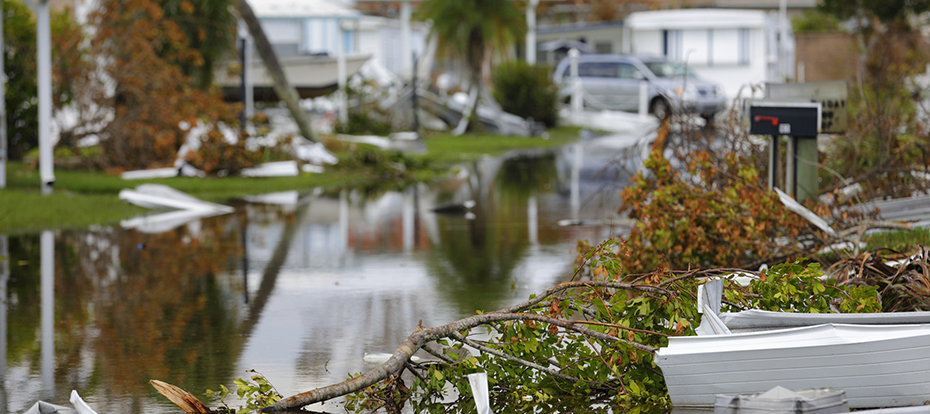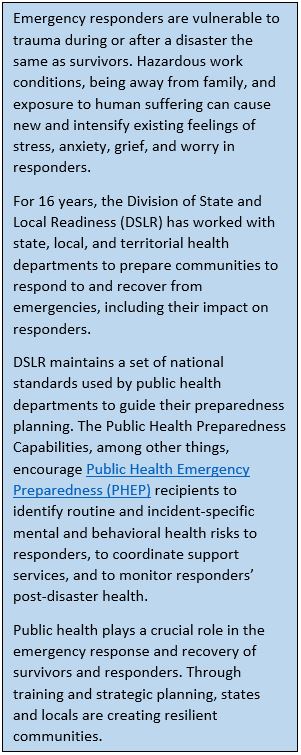Using Trauma-Informed Care to Guide Emergency Preparedness and Response
Posted on by
Exposure to a traumatic event or set of circumstances can negatively affect a person’s mental, physical, social, emotional or spiritual well-being for a long time after the initial incident. We know that not all individuals respond to trauma in the same way and we know that individuals with a history of trauma, especially childhood trauma, are more likely to experience psychological distress and are at increased risk for the development of Post-traumatic Stress Disorder (PTSD) with future exposure to trauma.
The chemicals in our bodies change during stressful or traumatic situations
When the body is threatened, stress hormones are released to help you survive (fight or flight response). These hormones cause our bodies to minimize non-essential tasks, including growth, reproduction, and immune function and to maximize body functions that are necessary to prepare the body to fight or flee from a stressor. Functions such as breathing, heart rate and alertness are useful for the body to survive the stress. If someone is regularly exposed to trauma, stress hormones are repeatedly released and the brain can become exposed to these powerful stress hormones that would normally be present in the body for short periods of time. Over time repeated exposure to stress may cause your body’s natural stress response system to malfunction and can result in potentially unhealthy mental and physical responses to current or future stress. These responses can include irritability, emotional reactivity, intrusive thoughts about the event, emotional numbing and avoidance, loss of one’s sense of safety, or diminished capacity to trust others.
Exposure to trauma can affect a person’s normal coping and stress management skills. A person’s mental health during an emergency may be impacted by:
- Direct exposure to the disaster, such as being evacuated or witnessing others (including family members) in life-threatening situations
- Prior experience with and exposure to trauma
- Pre-existing conditions, such as mental health conditions
- Socioeconomic factors, such as family resources available
- Family variables, for example, how parents react
Take trauma into account when responding to emergencies
When someone has experienced trauma, he or she can be re-traumatized if emergency medical service providers, healthcare professionals, and community service providers are not aware of and sensitive to the possibility of re-traumatization. Emergency responders should be aware that individuals and communities may have experienced a variety of traumas in their lives and need to consider a survivor’s physical, psychological, and emotional safety and well-being after a disaster.
Trauma-informed organizations and emergency responders need to be sensitive to the potential impact that widespread trauma can have on individuals. An essential underpinning of trauma informed care and approach is the awareness that procedures and interactions can be re-traumatizing.
Training emergency responders in trauma-informed care
The CDC’s Office of Public Health Preparedness and Response (OPHPR) collaborated with SAMHSA to develop a trauma-informed care training for CDC. Working with Mary Blake (SAMHSA) and the Technical Assistance Center, SAMHSA’s National Center for Trauma-Informed Care (NCTIC) developed and led a new training for OPHPR employees about the role of trauma-informed care during public health emergencies. The training aimed to increase responder awareness of the impact that trauma can have in the communities where they work. Participants learned the six principles that guide a trauma-informed approach, including:
- Safety
- Trustworthiness and transparency
- Peer support
- Collaboration and mutuality
- Empowerment, voice and choice
- Cultural, historical, and gender issues
Adopting a trauma-informed approach is not accomplished through any single particular technique or checklist. It requires constant attention, caring awareness, sensitivity and it may require a cultural change at an organizational level. On-going internal organizational assessment and quality improvement, as well as engagement with community stakeholders, will help to imbed this approach which can be augmented with organizational development and practice improvement. The training provided by OPHPR and NCTIC was the first step for CDC to view emergency preparedness and response through a trauma-informed lens.
Resources:
8 comments on “Using Trauma-Informed Care to Guide Emergency Preparedness and Response”
Comments listed below are posted by individuals not associated with CDC, unless otherwise stated. These comments do not represent the official views of CDC, and CDC does not guarantee that any information posted by individuals on this site is correct, and disclaims any liability for any loss or damage resulting from reliance on any such information. Read more about our comment policy ».


A new approach which allows the victim to be better understood. Which, in turns, leads to better treatment options. Almost a custom approach to victim care and disaster response.
Hello! Can this training be made available to jurisdictions. I saw the inforgraphic but would like to learn more.
Thanks,
Elizabeth Billingsley RN BSN
OKC-County Health Department
Emergency Preparedness and Response Department
Thanks for your comment. I have forwarded your question and contact information to the appropriate subject matter expert(s) for an answer.
Hi – excited to hear more about this initiative.
I echo Elizabeth’s request for access to this training and/or other resources that might be available for training at the local level. Appreciate the consideration.
Cheers,
Resham
Preparedness, Public Health – Seattle & King County
Currently working on our site specific emergency response plans for a large social service agency in down town Portland. It would be great to get some insight on how we can begin to integrate a trauma-informed approach into our emergency operations. is there any way to get access to the curriculum of this training, or at least some good references to research.
Is this Trauma-informed training resource still available? Have there been any updates or indications for it’s use in the COVID-19 Pandemic?
I kindly request access to the training and available resources.
Warmly,
Jonnie Williams, PsyD
Evolve Equity
We are also interested in getting this training, and in becoming T-t-T so that we can push it out to all of our local public health and healthcare coalition members.
Thanks for any assistance that you can provide!
Nancy Carlson, Disaster Behavioral Health Program Coordinator
MN Department of Health